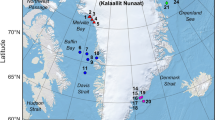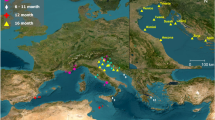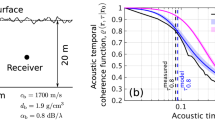Abstract
In recent years, the topic of noise in the sea and its effects on marine mammals has attracted considerable attention from both the scientific community and the general public. Since marine mammals rely heavily on acoustics as a primary means of communicating, navigating and foraging in the ocean, any change in their acoustic environment may have an impact on their behavior. Specifically, a growing body of literature suggests that low-frequency, ambient noise levels in the open ocean increased approximately 3.3 dB per decade during the period 1950–2007. Here we show that this increase can be attributed primarily to commercial shipping activity, which in turn, can be linked to global economic growth. As a corollary, we conclude that ambient noise levels can be directly related to global economic conditions. We provide experimental evidence supporting this theory and discuss its implications for predicting future noise levels based on global economic trends.
Similar content being viewed by others
Introduction
Ocean ambient noise, or the background din of the sea, is generated by a variety of sources of both natural and anthropogenic origin1,2,3. While ambient noise cannot be associated with a specific, identifiable source, it can be attributed to general types of sources. Natural causes include geophysical events such as wind-generated waves, earthquakes, precipitation and cracking ice, as well as biological phenomena such as whale songs, dolphin clicks and fish vocalizations. Anthropogenic sources include commercial shipping, geophysical surveys, oil drilling, dredging and sonar systems. The classical work of Wenz2 showed that ambient noise generated by this myriad of sources extends over a broad range of frequencies (1 to 100,000 Hz), but tends to be dominated by commercial shipping at low frequencies (< several hundred Hz) and wind-generated waves at high frequencies (> several hundred Hz). Although long-term changes in ambient noise levels may have significant impact on marine mammal behaviour1,4,5,6,7,8,9,10,11, our understanding of the trends in noise levels on decadal time scales remains very limited. Only at low frequencies has a body of experimental evidence emerged suggesting a gradual increase in noise levels, from measurements in the open ocean, during the second half of the 20th and early part of the 21st centuries12,13,14,15,16,17,18. Theoretical explanations of this trend are even more scarce19, with the consequence that predictions of future trends in noise levels are largely of a speculative nature.
Therefore, we propose theoretical underpinnings for the observed long-term trends that are based on the idea that temporal changes in low-frequency noise are primarily due to changes in commercial shipping activity. Furthermore, we show that shipping activity can be directly related to global economic conditions and as a corollary, that ambient noise levels are correlated with the state of the global economy. First, we present the experimental evidence that led to the development of this theory. Then we derive the quantitative relationship among ambient noise levels, shipping activity and the global economic condition. Finally, we proffer a prediction of ambient noise levels in 2030 based on the projected state of the global economy.
Results
Figure 1 provides a summary of existing data on trends in low-frequency ambient noise levels. The plot delineates two fundamental categories of noise, namely, that which is of natural or biological origin and that which is of anthropogenic origin, specifically, shipping. The natural/biological component was estimated from measurements acquired in areas of the South Pacific with extremely low ship traffic20 and is corroborated by data acquired in other regions of the world's oceans21,22. Measurements of the time dependence of this component are unavailable and it is assumed to remain constant during the period shown in the figure. In fact, temporal variability in the low-frequency, natural/biological contribution may be attributable to several factors, including: (1) depletion of the whale population due to the burgeoning whaling industry; (2) increased ice cracking and breaking wave activity associated with global climate change; and (3) variation in undersea seismic activity. Nevertheless, actual changes in natural/biological noise levels would very likely be overshadowed by the anthropogenic contribution from commercial shipping traffic1. The available data on low-frequency shipping noise12,13,14,15,16,17,18 are restricted to the Northeast Pacific Ocean and show a gradual increase in level of approximately 19 dB (decibels re 1 μPa2/Hz) during the period 1950–2007. Even though the data in the early part of the 21st century suggest a levelling off (or even a decrease at some locations) in noise levels17, there appears to be incontrovertible evidence that noise levels increased at approximately a rate of 3.3 dB per decade from 1950 to 2007.
Available data on trends in ambient noise levels.
Measurements of ambient noise levels in the frequency band 25–50 Hz show an increase of approximately 19 dB during the period 1950–2007, corresponding to a rate of increase of 3.3 dB per decade. The baseline value20 of 52 dB (in yellow) is associated with natural/biological noise and is assumed to be constant during this time period. The anthropogenic component (in red) is associated with commercial shipping noise and was estimated from measurements made in the Northeast Pacific Ocean in 195014, 196512, 197818, 198018, 198618, 200115 and 200717.
Figure 2 illustrates the growth of the world fleet since World War II23. Both the gross tonnage and the number of ships display an approximate exponential growth rate during the time period shown in Fig 1. As we shall see, this corresponds to a linear rate of increase on a logarithmic (dB) scale. We will focus on the gross tonnage as the meaningful metric in our theory, demonstrating that our approach to incorporating the shipping contribution is a macroscopic one. This method is to be contrasted with the more conventional, microscopic approach in which detailed acoustic source mechanisms, such as propeller cavitation and mechanical vibration of ship's machinery, are related to parameters such as ship speed and length to arrive at estimates of ship-radiated noise13,24.
Growth of the world fleet since World War II.
The growth of the world fleet23 for the time period of interest is shown as an increase in the gross tonnage (in red) and the number of ships (in blue).
Figure 3 shows the growth of the world Gross Domestic Product (GDP) during the period 1950–201025,26. The world GDP also exhibits an exponential growth rate during the time period of interest, corresponding to a linear rate of increase on a dB scale.
The key to the theory of noiseonomics lies in determining the relationship among the three exponentially growing quantities shown in Figs. 1–3. The underlying assumptions associated with this theory are:
Assumption 1: Long-term changes in low-frequency, ambient noise levels are primarily of anthropogenic origin.
Assumption 2: Commercial shipping activity is the principal anthropogenic source of long-term changes in ambient noise levels at low frequencies and is concentrated in the northern hemisphere, which is the location of most of the world's ship traffic.
Assumption 3: Long-term changes in ambient noise levels due to shipping have occurred since the onset of the Industrial Revolution in 1850, when a major shift from sailing vessels to powered vessels began to occur. Unfortunately, there appear to be no available data on ambient noise levels during the period 1850–1950.
With these assumptions, the theory of noiseonomics is summarized below:
Hypothesis 1: Low-frequency, ambient noise levels are directly correlated with the gross tonnage of the world fleet.
Hypothesis 2: The gross tonnage of the world fleet is directly correlated with the world gross domestic product.
Corollary: Ambient noise levels are correlated with the world gross domestic product.
In order to quantify this theory, we define the following decibel quantities:



Note that the reference quantity in Eq. (1) is the standard one used in ocean acoustics, while the reference quantities in Eqs. (2) and (3) are chosen for convenience in displaying the results. Figure 4 shows the results of applying Eqs. (1)-(3) to the data in Figs. 1–3 and presenting the results on the same decibel plot. We see that the rate of growth of all three quantities is approximately 3.3 dB per decade, thereby confirming the correlation among low-frequency ambient noise level, world fleet gross tonnage and world gross domestic product. Examining the relationship among the linear fits in Fig. 4, we can further quantify the noiseonomics theory:

Long-term trends in ambient noise levels, gross tonnage of the world fleet and world gross domestic product.
Measurements of ambient noise levels, world fleet gross tonnage and world gross domestic product are plotted as decibel (dB) quantities for the period 1950–2007. Linear fits to the data for all three quantities (using Excel) show similar slopes of 3.3 dB per decade with high goodness of fit (R2) factors.
Discussion
Equation (4) provides us with the capability to predict ambient noise levels from knowledge of the world gross domestic product. For example, one economic forecast27 (made in 2005) predicts a world GDP of 89,480,000 international 1990 mega $ in 2030. Substituting this value into Eq. (3) and using Eq. (4), we obtain a predicted ambient noise level of 96 dB in 2030. When compared to a noise level of 91 dB in 2007 (cf. Fig. 1), this corresponds to a rate of increase of 2.2 dB per decade. Since the economic forecast was made prior to the onset of the current global recession, we can speculate that the world GDP in 2030 will in fact be lower than predicted and therefore the projected ambient noise level will be lower as well. This behavior is also consistent with the more recent ambient noise data17, which are most likely a reflection of the global economic downturn.
Furthermore, we note that mathematical modeling of global economic trends is an active area of research in the economics community and has produced a variety of models to explain and predict the behavior of the dynamic world economy28,29,30. The noiseonomics concept suggests that these models could be used to generate predictions of future ambient noise levels. Conversely, it conjures up the intriguing idea that measurements of low-frequency, ambient noise levels could be used as metrics for assessments of global economic growth rates.
Finally, it is important to point out that Eq. (4) is the first attempt to establish a quantitative relationship between ambient noise levels and global economic trends. In the future, this equation may require refinement in order to incorporate: (1) new ambient noise measurements and global economic data; (2) noise mitigation measures, including the use of more energy efficient, quieter propulsion systems in newer ships; and (3) observations of long-term variability in natural/biological noise.
References
National Research Council, Ocean Noise and Marine Mammals (National Academy Press, 2003).
Wenz, G. M. Acoustic ambient noise in the ocean: Spectra and sources. J. Acoust. Soc. Am. 34, 1936–1956 (1962).
Hildebrand, J. A. Anthropogenic and natural sources of ambient noise in the ocean. Mar. Ecol. Prog. Ser. 395, 5–20 (2009).
Foote, A. D., Asborne, R. W. & Hoelzel, A. R. Whale-call response to masking boat noise. Nature 428, 910 (2004).
National Research Council, Marine Mammal Populations and Ocean Noise: Determining When Noise Causes Biologically Significant Effects (National Academy Press, 2005).
Nowacek, D. P., Thorne, L. H., Johnston, D. W. & Tyack, P. L. Responses of cetaceans to anthropogenic noise. Mammal Rev. 37, 81–115 (2007).
Weilgart, L. S. The impacts of anthropogenic ocean noise on cetaceans and implications for management. Can. J. Zool. 85, 1091–1116 (2007).
Tyack, P. L. Implications for marine mammals of large-scale changes in the marine acoustic environment. J. Mammal. 89, 549–558 (2008).
Clark, C. W. et al. Acoustic masking in marine ecosystems: intuitions, analysis and implication. Mar. Ecol. Prog. Ser. 395, 201–222 (2009).
Boyd, I. L. et al. An International Quiet Ocean Experiment. Oceanography 24(2), 174–181, http://dx.doi.org/10.5670/oceanog.2011.37 (2011).
Rolland, R. M. et al. Evidence that ship noise increases stress in right whales. Proc. R. Soc. B, doi: 10.1098/rspb.2011.2429 (2012).
Wenz, G. M. Low frequency deep water ambient noise along the Pacific coast of the United States. U.S. Navy J. Underwater Acoust. 19, 423–444 (1969).
Ross, D. Mechanics of Underwater Noise (Pergamon, 1976).
Ross, D. On ocean underwater ambient noise. Acoust. Bull. 18, 5–8 (1993).
Andrew, R. K., Howe, B. M., Mercer, J. A. & Dzieciuch, M. A. Ocean ambient sound: Comparing the 1960's with the 1990's for a receiver off the California coast. ARLO 3, 65–70 (2002).
McDonald, M. A., Hildebrand, J. A. & Wiggins, S. M. Increases in deep ocean ambient noise in the Northeast Pacific west of San Nicolas Island, California. J. Acoust. Soc. Am. 120, 711–718 (2006).
Andrew, R. K., Howe, B. M. & Mercer, J. A. Long-time trends in ship traffic noise for four sites off the North American West Coast. J. Acoust. Soc. Am. 129, 642–651 (2011).
Chapman, N. R. & Price, A. Low frequency deep ocean ambient noise trend in the Northeast Pacific Ocean. J. Acoust. Soc. Am. 129, EL161–EL165 (2011).
Frisk, G. V. Noiseonomics: The relationship between ambient noise levels and global economic trends. Invited paper presented at Pacific Rim Underwater Acoustics Conference 2007, Vancouver, BC, Canada.Available online at http://pruac.apl.washington.edu/abstracts/Frisk.pdf (2007)
Cato, D. H. Ambient sea noise in waters near Australia. J. Acoust. Soc. Am. 60, 320–328 (1976).
Gaul, R. D., Knobles, D. P., Shooter, J. A. & Wittenborn, A. F. Ambient noise analysis of deep-ocean measurements in the Northeast Pacific. IEEE J. Ocean. Eng. 32, 497–512 (2007).
Reeder, D. B., Sheffield, E. S. & Mach, S. M. Wind-generated ambient noise in a topographically isolated basin: A pre-industrial era proxy. J. Acoust. Soc. Am. 129, 64–73 (2011).
Colton, T. Growth of the World Fleet since WWII, 1914–2009. http://shipbuildinghistory.com/today/statistics/wldfltgrowth.htm (2010)
Wales, S. C. & Heitmeyer, R. M. An ensemble source spectra model for merchant ship-radiated noise. J. Acoust. Soc. Am. 111, 1211–1231 (2002).
The Conference Board Total Economy Database. http://www.conference-board.org/data/economydatabase// (2011)
Maddison, A. The World Economy – A Millenial Perspective (Paris: Organization for Economic Co-operation and Development, 2001).
Maddison, A. Evidence submitted to the Select Committee on Economic Affairs, House of Lords, London, for the inquiry into “Aspects of the Economics of Climate Change” (20 February 2005).
Solow, R. M. A contribution to the theory of economic growth. Q. J. Econ. 70, 65–94 (1956).
Ventura, J. A Global View of Economic Growth. Working Paper 11296, National Bureau of Economic Research, Cambridge, MA (2005).
Okada, T. What does the Solow Model tell us about economic growth? Contrib. Macroeconomics 6, 1–30 (2006).
Acknowledgements
This work was supported by the Office of Naval Research and Florida Atlantic University. The assistance of George Buzyna, Daniel Frisk and Marjorie Parmenter in the preparation of the manuscript is gratefully acknowledged.
Author information
Authors and Affiliations
Contributions
G.V.F. is the sole author.
Ethics declarations
Competing interests
The author declares no competing financial interests.
Rights and permissions
This work is licensed under a Creative Commons Attribution-NonCommercial-ShareALike 3.0 Unported License. To view a copy of this license, visit http://creativecommons.org/licenses/by-nc-sa/3.0/
About this article
Cite this article
Frisk, G. Noiseonomics: The relationship between ambient noise levels in the sea and global economic trends. Sci Rep 2, 437 (2012). https://doi.org/10.1038/srep00437
Received:
Accepted:
Published:
DOI: https://doi.org/10.1038/srep00437
This article is cited by
-
Vessel noise exposures of harbour seals from the Wadden Sea
Scientific Reports (2023)
-
Statistical study on shallow water soundscape variability of Eastern Arabian Sea using noise level metrics
Environmental Monitoring and Assessment (2023)
Comments
By submitting a comment you agree to abide by our Terms and Community Guidelines. If you find something abusive or that does not comply with our terms or guidelines please flag it as inappropriate.







